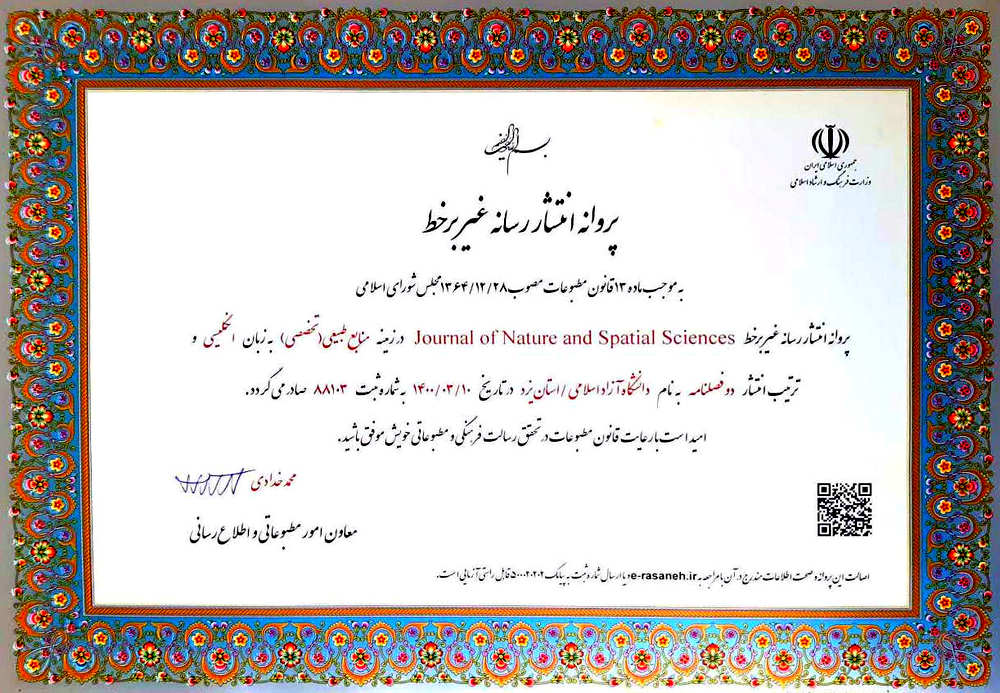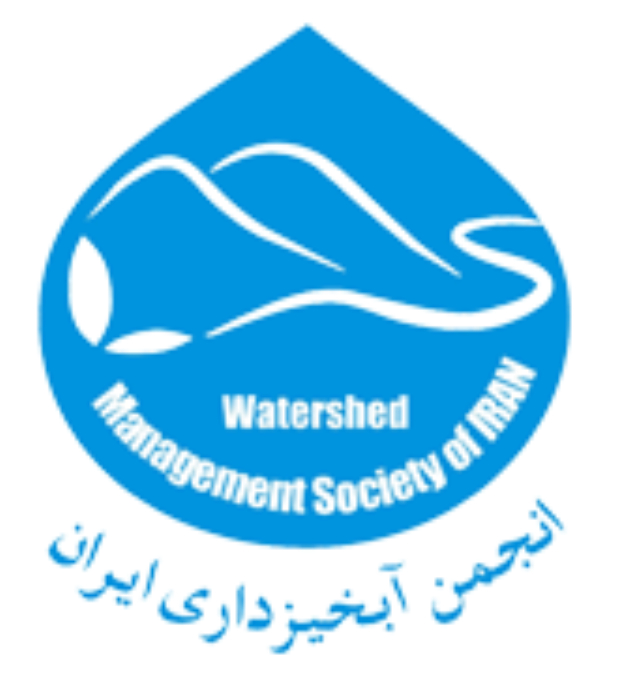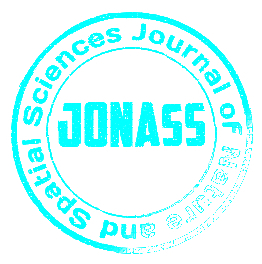About the journal
JONASS received an "Green" rank in Publish Status in the newest Journal Evaluation
Journal of Nature and Spatial Sciences (JONASS) ISSN: 2783-1604, (J. nat. spatial sci.) is a peer-reviewed scientific journal dedicated to publishing high-quality scientific research work in the broad field of spatial sciences.
JONASS was approved by the 7th Commission of the Central Organization of the Islamic Azad University in the summer of 2020 (License No. 21319, dated 22/02/1399 AH) and was indexed in (link). (Factors for IAU evaluation)
The aim of the journal is to obtain valuable national and international indexes by publishing the second and third issues.
Use the JONASS template1, then submit your best paper in the template. JONASS is an open-access journal and provides immediate open access to its content on the principle that making research freely available to the public supports a greater global exchange of knowledge. All publishing in JONASS is free of charge. This journal has Digital Object Identifier (DOI) allotment for the articles.
Important |
|
Information |
| Title | Journal of Nature and Spatial Sciences | |
| Abbreviation | J. nat. spatial sci. | |
| Publication Type | Journal | |
| Subject Area, Categories, Scope | Nature, Spatial Science (GIS, RS, ), Earth, Environment | |
| Publisher | Islamic Azad University | |
| Types of articles | Review article, research article, case study, extension article, and short communication | |
| Article Processing Charges (APC) | free of charge | |
| DOI | 10.30495/jonass. | |
| Peer Review Policy | Double-Blind Peer Review |

|
-
Open Access Article
1 - Identification of safety hazards and risk assessment using the Hazid technique and designing strategic policies in the SWOT matrix
Seyed. Mahmoud Mir ، Bizhan Maghsoudlou Kamaali * ، Mojgan ShajariIssue 1 , Vol. 4 , Spring_Summer 2024 -
Open Access Article
2 - Analyzing the Interactions Between Surface Temperature, Vegetation, and Topography in Jakarta (Indonesia) and Seoul (South Korea)
Samaneh Mirmiran *Issue 1 , Vol. 4 , Spring_Summer 2024 -
Open Access Article
3 - Site Selection for Green Space Centers Using Fuzzy Logic Model in Geographic Information Systems: A Case Study of Yazd, Iran
Ali Gholami Javadieh * ، Malihe ZakerianIssue 1 , Vol. 4 , Spring_Summer 2024 -
Open Access Article
4 - Utilizing NASA Giovanni and Google Earth Engine for Dust Analysis in Northeast and East Iran: A 40-Year Study Using MODIS, MERRA-2, and Sentinel-5 Data to Assess Relationships with Wind and Vegetation
Sajad Jalil * ، Alireza Nouri ، Ali Akbar JamaliIssue 1 , Vol. 4 , Spring_Summer 2024 -
Open Access Article
5 - Comparative Analysis of NO2, SO2, CO, HCHO, and Aerosol Concentrations in Shanghai and Dubai Using Satellite Imagery from NASA's Giovanni and Sentinel-5P within Google Earth Engine
Sadegh Mokhtarisabet * ، Mohammad Morovati *Issue 1 , Vol. 4 , Spring_Summer 2024 -
Open Access Article
6 - Investigating the Spatial and Temporal Variation of NO2 Pollutant Obtained from Sentinel 5P Satellite in Cities of Yazd Province-Iran
Samaneh Mozaffari * ، Sadegh Mokhtarisabet *Issue 1 , Vol. 4 , Spring_Summer 2024 -
Open Access Article
7 - Optimal Site Selection for Construction Waste Disposal in Yazd City-Iran Using Multi-Criteria Decision Analysis (MCDA) and GIS Tools
Mohammad Hassanzadeh Nafooti *Issue 1 , Vol. 4 , Spring_Summer 2024 -
Open Access Article
8 - Investigating the correlation between Land Surface Temperature, Vegetation Coverage, Methane (CH4) concentration, precipitation, and wind, and their effects on the tourism rate in Bangkok and London using Google Earth Engine (GEE)
Samaneh Dameshghian *Issue 1 , Vol. 4 , Spring_Summer 2024 -
Open Access Article
9 - Analysis of Climate Change and Air Pollution Using GEE in a Beijing and Mumbai
Sahar Hadidian *Issue 1 , Vol. 4 , Spring_Summer 2024 -
Open Access Article
10 - Evaluating the Relationship Between Dust Concentrations and Nitrogen Dioxide Levels: A Comparative Study of Kerman and Isfahan- Iran
Sajed Rezazadeh * ، Ali Akbar Jamali ، Malihe Zakerian ، Hossein HatefiIssue 1 , Vol. 4 , Spring_Summer 2024 -
Open Access Article
11 - Assessment of Urban Heat Island Effects in Mashhad and Neishabour-Iran: A MODIS Imagery Approach
Razieh Mirfazlolah * ، Sadegh Mokhtarisabet *Issue 1 , Vol. 4 , Spring_Summer 2024 -
Open Access Article
12 - Spatial and Temporal Analysis of NO2 Pollution in Tehran Province Using Giovanni: Insights for Air Quality Management in Iran
Mojtaba khosravi Babadi *Issue 1 , Vol. 4 , Spring_Summer 2024
-
Open Access Article
1 - A review of project planning using the Logical Framework Approach (LFA) and Participatory Rural Appraisal (PRA)
Zeinab Karimi *Issue 2 , Vol. 3 , Autumn_Winter 2023 -
Open Access Article
2 - Subsidence risk zoning in Varamin County based on effective criteria using TOPSIS and VIKOR techniques
Ali Taheri * ، Moslem Dehnavi EelaghIssue 2 , Vol. 3 , Autumn_Winter 2023 -
Open Access Article
3 - Assessing spatial variations of vegetative drought in Razavi-Khorasan province, northeast of Iran
Ali Bagherzadeh * ، Reza Mahjoubin ، Ehsan Afshar ، Ali BakhshiIssue 2 , Vol. 2 , Autumn_Winter 2022 -
Open Access Article
4 - Intensity evaluation of fire and restoration process of the forest using remote sensing techniques (Case Study: North Ukraine)
Moslem Dehnavi Eelagh * ، Ali TaheriIssue 2 , Vol. 3 , Autumn_Winter 2023 -
Open Access Article
5 - Investigating suitability of land use based on land capability Lake Urmia basin area
Morteza Eyvazi * ، Ali Akbar Nazari Samani ، Sara ParviziIssue 2 , Vol. 3 , Autumn_Winter 2023 -
Open Access Article
6 - The relationship between the land surface temperature, changes in the vegetation cover and air pollutants using the Google Earth Engine
Razieh Mirfazlolah *Issue 2 , Vol. 3 , Autumn_Winter 2023 -
Open Access Article
7 - Analysis of dust changes using satellite images in Giovanni NASA and Sentinel in Google Earth Engine in western Iran
Narges Ghane Ezabadi * ، Susan Azhdar ، Ali Akbar JamaliIssue 1 , Vol. 1 , Spring_Summer 2021 -
Open Access Article
8 - Evaluating the changes in Gavkhuni Wetland using MODIS satellite images in 2000-2016
Maryam Zarei ، Mahdi Tazeh * ، Vahid Moosavi ، Saeideh KalantariIssue 1 , Vol. 1 , Spring_Summer 2021 -
Open Access Article
9 - Application of hierarchy-fuzzy analysis models and artificial neural networks in locating urban waste burial (Case Study: Lali city)
Fatemeh Amiri ، Ladan Khedri Gharibvand * ، Asghar KhedrifarIssue 1 , Vol. 3 , Spring_Summer 2023 -
Open Access Article
10 - Identifying future climatic change patterns at basin level in Baja California, México
Teodoro Teodoro Carlón Allende ، Erna López Granados ، Manuel Mendoza *Issue 2 , Vol. 1 , Autumn_Winter 2021














